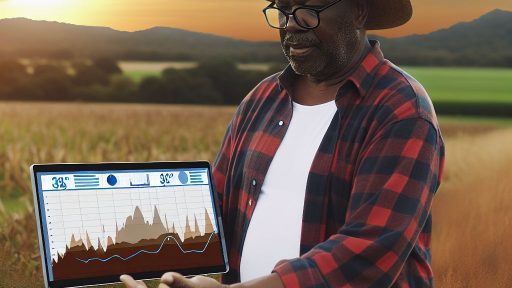Introduction to AgTech
Definition and Importance in Rural Contexts
AgTech refers to agricultural technology that enhances farming efficiency.
It plays a crucial role in modern agriculture and rural development.
Innovations include precision farming, automated irrigation, and data analytics.
These technologies streamline operations and reduce resource waste.
Consequently, farmers can maximize yields and profit margins.
Moreover, AgTech improves sustainability by promoting environmentally friendly practices.
Technologies like remote sensing monitor crop health and soil conditions.
This allows for timely interventions and better decision-making.
Additionally, AgTech fosters economic growth in rural communities.
With increased productivity, local economies benefit significantly.
Many startups focus on creating AgTech solutions for diverse farming challenges.
For example, companies like CropX utilize soil data to optimize water usage.
Such innovations encourage the adoption of smart farming worldwide.
Overall, AgTech is reshaping the agricultural landscape and boosting rural real estate.
As a result, it attracts investment in both land and agricultural infrastructure.
Transform Your Agribusiness
Unlock your farm's potential with expert advice tailored to your needs. Get actionable steps that drive real results.
Get StartedOverview of Key AgTech Innovations Impacting Rural Real Estate
Precision Agriculture
Precision agriculture revolutionizes farming practices with technology.
Farmers use data analytics to optimize yield and resources.
Therefore, they make informed decisions about land use and investments.
Additionally, this innovation increases the overall productivity of rural properties.
Drones and Aerial Imagery
Drones enable farmers to monitor fields from above.
This technology provides detailed images and data about crop health.
Consequently, landowners can assess their property’s value more accurately.
Moreover, drones reduce labor costs and improve operational efficiency.
IoT and Smart Devices
The Internet of Things (IoT) connects devices on farms.
Smart sensors monitor weather, soil moisture, and crop conditions.
Thus, farmers can respond quickly to changing environmental factors.
This responsiveness enhances land development opportunities in rural areas.
Biotechnology and Genomics
Biotechnology plays a critical role in developing resilient crops.
This innovation improves yields while reducing exposure to pests and diseases.
As a result, rural real estate becomes more attractive for investors.
Furthermore, it helps landowners maximize the potential of their properties.
Sustainable Practices
Sustainable agriculture practices promote long-term land health.
Farmers adopt techniques such as crop rotation and cover cropping.
These methods enhance soil quality and reduce erosion.
Consequently, sustainable practices increase the desirability of rural lands.
Real-Time Monitoring and Data Analysis
Real-time monitoring allows farmers to track their operations continuously.
They can analyze data to optimize crop management and yield outcomes.
Therefore, this level of oversight instills confidence in property investments.
Investors view data-driven strategies as reliable indicators of future performance.
Showcase Your Farming Business
Publish your professional farming services profile on our blog for a one-time fee of $200 and reach a dedicated audience of farmers and agribusiness owners.
Publish Your ProfileThe Role of Precision Agriculture in Land Development Decisions
Defining Precision Agriculture
Precision agriculture utilizes technology to enhance farming practices.
It involves collecting data on soil, crops, and weather conditions.
This approach aims to optimize field-level management regarding crop farming.
Impact on Land Value
Precision agriculture significantly influences land value in rural areas.
Investors recognize that high-tech farms produce more yield.
Consequently, this can lead to increased property demand.
Enhancing Decision-Making
Farmers make informed land development decisions through data analytics.
They assess variables such as soil quality and moisture levels.
This information helps determine the best land use practices.
Resource Management
Effective resource management stems from precision agriculture technologies.
Farmers save on inputs like water, fertilizers, and pesticides.
This not only reduces costs but also improves sustainability.
Attracting Investment
Technological advancements in agriculture attract investors to rural areas.
Investors are drawn by the potential for higher returns on agricultural land.
Moreover, innovative practices often lead to better land productivity.
Challenges and Considerations
Despite its benefits, precision agriculture faces challenges.
Initial investment costs can deter some farmers.
Additionally, ongoing education on technology usage is crucial.
Future Trends
The future of rural real estate relies on advancements in precision agriculture.
As technologies evolve, so will farming practices and land development.
Ultimately, this innovation promises a more sustainable approach to agriculture.
Learn More: How Climate Affects Pest Control Strategies in Farmland Communities
How Drones and GIS Technology Transform Land Assessment Processes
The Role of Drones in Land Assessment
Drones enhance land assessment through aerial imagery and data collection.
They allow for rapid surveys of large areas.
Moreover, drones provide high-resolution images that reveal detailed landscape features.
This technology aids in identifying soil types and vegetation health.
Furthermore, drones assist in monitoring crop conditions efficiently.
As a result, landowners obtain better insights to make informed decisions.
GIS Technology: A Powerful Tool for Analysis
Geographic Information Systems (GIS) analyze and visualize spatial data.
GIS integrates data from various sources, offering a comprehensive view of land.
This tool allows users to overlay different data sets for better insights.
For instance, land use patterns and topographical features can be examined together.
Consequently, value assessments and development plans improve significantly.
GIS technology also aids in identifying potential environmental impacts.
Combining Drones and GIS for Optimal Outcomes
Integrating drones with GIS creates a powerful land assessment strategy.
This combination allows for real-time data capture and analysis.
Land developers can visualize potential issues before they arise.
Moreover, this integration streamlines the decision-making process.
It fosters collaboration among stakeholders through shared visuals and data analytics.
Ultimately, enhanced accuracy leads to smarter land development practices.
Showcase Your Farming Business
Publish your professional farming services profile on our blog for a one-time fee of $200 and reach a dedicated audience of farmers and agribusiness owners.
Publish Your ProfileCase Studies in Modern Application
Several projects demonstrate the effectiveness of these technologies.
For example, a recent study in Iowa utilized drones for crop monitoring.
The gathered data informed growers about fertilizer needs.
Another case in California used GIS to plan efficient water use.
These case studies underscore the value of adopting these innovative tools.
Organizations that leverage these technologies outperform their competitors.
Discover More: The Role of Sustainable Practices in Agricultural Land Valuation
The Impact of Smart Irrigation Systems on Property Value and Utility
Enhancing Water Efficiency
Smart irrigation systems significantly enhance water efficiency in agriculture.
They use advanced technology to optimize water usage.
This results in less waste during irrigation cycles.
Farmers can monitor soil moisture levels in real-time.
Moreover, automated adjustments ensure optimal watering schedules.
Ultimately, this efficiency reduces operational costs.
Increasing Crop Yields
Increased water management leads to higher crop yields.
With improved irrigation, plants receive consistent moisture.
This consistency boosts productivity levels across various crops.
Higher yields translate to increased profitability for farmers.
Consequently, land value rises in response to better performance.
Impact on Property Value
Smart irrigation systems directly affect property values.
Properties equipped with such systems often sell for premium prices.
Investors recognize the long-term benefits of water-saving technologies.
A well-implemented system can be a significant selling point.
This attraction often leads to quicker sales and higher demand.
Utility and Sustainability Benefits
Smart irrigation promotes sustainability in rural areas.
Efficient water use supports local ecosystems and biodiversity.
This approach helps combat drought conditions prevalent in many regions.
Furthermore, municipalities are likely to reward sustainable practices.
These factors contribute to a community’s overall attractiveness.
Adoption Trends
The adoption of smart irrigation systems is on the rise.
Many rural landowners are investing in these technologies.
Government incentives also promote their implementation.
As technology costs decrease, accessibility improves.
Landholders gain confidence in innovative agricultural practices.
You Might Also Like: The Role of Regenerative Farming in Long-Term Land Investment Returns

AgTech’s Influence on Sustainable Land Development Practices
Introduction to AgTech in Rural Development
AgTech plays a crucial role in transforming rural land development.
It integrates technology with agriculture to enhance productivity.
This evolution promotes sustainable practices in land management.
Efficiency in Resource Management
Sustainable land development relies on effective resource management.
AgTech solutions optimize water usage for irrigation purposes.
Additionally, technologies help minimize waste through precision farming.
Showcase Your Farming Business
Publish your professional farming services profile on our blog for a one-time fee of $200 and reach a dedicated audience of farmers and agribusiness owners.
Publish Your ProfileFarmers leverage data analytics for informed decision-making.
Soil Health and Biodiversity
AgTech innovations support soil health and biodiversity.
Cover cropping and crop rotation enhance soil nutrients.
Moreover, they reduce dependency on chemical fertilizers.
This approach promotes a healthier ecosystem.
Climate Resilience
Climate change poses significant challenges to agriculture.
AgTech helps farmers adapt through innovative practices.
For instance, climate forecasting tools inform planting schedules.
Additionally, breeders develop resilient crop varieties to withstand stress.
Social Impact and Community Development
AgTech influences rural communities, not just economies.
Access to technology fosters skill development among farmers.
Furthermore, it encourages local entrepreneurship through innovation.
Community engagement initiatives enhance knowledge sharing among peers.
Future Trends in AgTech and Land Development
The future of AgTech looks promising for land development.
Emerging technologies will further improve agricultural practices.
Blockchain can enhance transparency within supply chains.
As a result, farmers can gain better access to market opportunities.
Role of AgTech in Sustaining Rural Areas
AgTech innovations play a vital role in shaping sustainable practices.
They ensure the long-term viability of rural real estate and agriculture.
By embracing technology, rural areas can thrive sustainably.
Uncover the Details: Soil Erosion Control Strategies for Waterfront and Hillside Properties
The Economic Effects of AgTech on Rural Communities and Real Estate Markets
Boosting Local Economies
AgTech innovations significantly boost local economies in rural areas.
New technologies enhance agricultural productivity and efficiency.
Farmers can produce more with fewer resources due to these advancements.
This increased efficiency leads to higher incomes for local producers.
Consequently, these farmers can invest more in their communities.
Local businesses also benefit from increased purchasing power.
Increasing Land Values
AgTech developments influence land values in rural real estate markets.
As productivity rises, the demand for agricultural land also increases.
Investors are attracted to areas implementing AgTech solutions.
This demand drives up property values and rental rates.
Landowners experience enhanced equity from these rising prices.
Job Creation and Workforce Development
AgTech contributes to job creation in rural communities.
New businesses emerge to support technological advancements in agriculture.
Many of these new jobs require skilled labor, boosting education initiatives.
Communities respond by improving workforce training programs.
In turn, this development creates a more skilled and competitive workforce.
Challenges and Considerations
While AgTech brings numerous benefits, challenges still exist.
Access to technology can be limited in some rural areas.
Investments in infrastructure are often required to fully realize benefits.
Showcase Your Farming Business
Publish your professional farming services profile on our blog for a one-time fee of $200 and reach a dedicated audience of farmers and agribusiness owners.
Publish Your ProfileAdditionally, the high cost of technology can deter some farmers.
Local governments may need to provide support for broader access.
Sustainability and Environmental Impact
AgTech also plays a crucial role in promoting sustainability.
Precision agriculture reduces the use of water and chemicals.
This shift enhances environmental health while maintaining productivity.
Consequently, rural communities embrace more eco-friendly practices.
This focus on sustainability can further attract new residents and businesses.
Future Trends: Emerging AgTech Innovations and Their Potential Impact on Rural Land Development
Smart Farming Technologies
Smart farming technologies enhance productivity in rural areas.
For instance, precision agriculture uses data analytics for efficient resource management.
Moreover, IoT devices enable farmers to monitor crops remotely.
Vertical Farming Solutions
Vertical farming revolutionizes space usage in rural real estate.
This innovation allows farming in urban environments and small plots.
Consequently, it can maximize yield without requiring extensive land.
Agroecological Practices
Agroecological practices promote sustainability in agricultural land use.
These methods enhance soil health and biodiversity.
Furthermore, they reduce the dependency on chemical inputs.
Blockchain for Supply Chain Transparency
Blockchain technology fosters transparency in agricultural production.
This innovation improves traceability of food products from farm to table.
As a result, it builds consumer trust and ensures product quality.
Drone Technology for Land Assessment
Drone technology provides efficient land assessment and monitoring.
Drones can cover large areas quickly, providing vital data.
This data supports decision-making in land development and management.
Impact on Rural Real Estate
These AgTech innovations transform rural real estate markets.
Investors recognize the potential for agricultural productivity and sustainability.
Consequently, land values may see significant increases.
Government and Policy Support
Government initiatives facilitate the adoption of AgTech solutions.
Subsidies and grants encourage investment in innovative farming practices.
Additionally, policy frameworks support sustainable land development steps.




